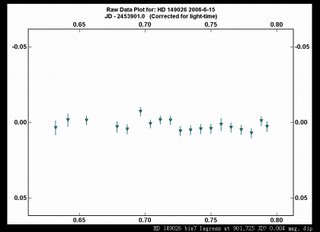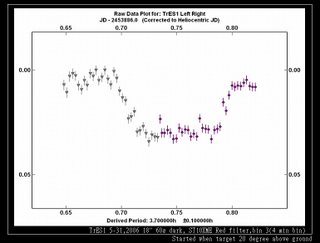Friday, June 23, 2006
Wednesday, June 21, 2006
Tuesday, June 20, 2006
First try on HD 149026 (known transit 0.005 mag)



HD 149026 was known to have transit.
The transit window center was predicted to be HJD 2453904.63 or June 18, 3:04 UT
I observed from 04:30 to 07:55 UT (total 3: 25) and should have detect the egress.
I searched the S&T and there were only two articles on HD 149026! So the exact time is very poorly known!
Most likely the egress occurred before x.7 JD (0.74 -0.7) and the error could be as little as 0.05 JD or 1.2 hr.
If we "think" the ingress was at 0.70 JD, then the error is (0.7-0.52)=0.18 JD or 4.3 hr!
But because we don't know the exact timing of previous transit, either way is possible.
Sunday, June 18, 2006
Wednesday, June 14, 2006
Monday, June 12, 2006
HD 189733 transit



On June 11 (UT) I was in Arizona and used a 3" refractor mounted on my 18" remote telescope in New Mexico Skies to try to get the exoplanet transit of HD 189733 near M27.
I am glad to report that the observation was successfully and both the ingress and egress was definitely detected and recorded. But there was a very interesting observation.
When planning the observation, I visited www.transitsearch.org for HD 189733's transit window timing (http://www.ucolick.org/~laugh/HD189733_b.transits.txt). The mid point should be around JD 2453897.89 or June 11 09:18 UT.
As a double check, I visited Beglium amateur Tonny Vanmunster 's web page. Ron Bissinger (California) had observed HD 189733b transit successfully in 2005 Oct. 10 and recorded the transit midpoint at JD 2453653.79 <http://users.skynet.be/fa079980/non_cv_2005
/images/exoplanet_HD189733_bissinger.gif) >
Since the period of HD 189733b was calculated to be 2.219 d (+/- 0.0005). My observation happened to be exactly 110 cycles after Ron Bissinger's Oct. 10, 2005 detection.
The math is as below:
JD 2453653.79 + 2.219 * 110 = JD 2453897.88, which agree with the prediction time given by www.transitsearch.org to within 15 minutes!
So I schedulled my observation to begin exactly 1 hr before transit and 1 hr after. The fact that I almost have missed the ingress really surprised me. There are two conclusions:
1. The actual period is a bit shorter than the stated 2.219d obtained by radial velocity calculation. It should be more like 2.2186d [ (2453897.84-2453653.79) / 110 ]
2. If such a well known exoplanet's transit center time could be off by 1 hr after just 110 cycles. Imagine how much it could be off for other exoplanets candidates like HD 188753 which has no previous detection? I won't be surprised that it could be off by as much as 5, 6 hrs.



















